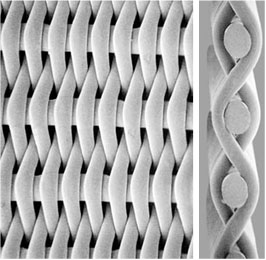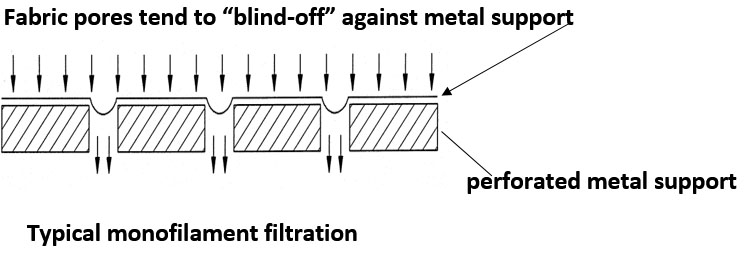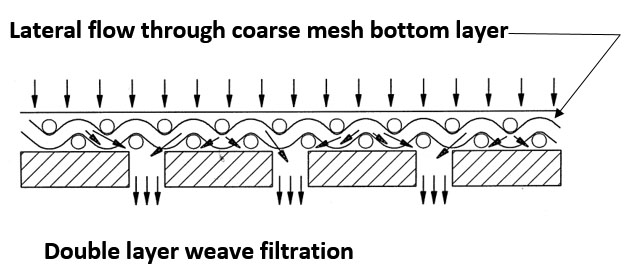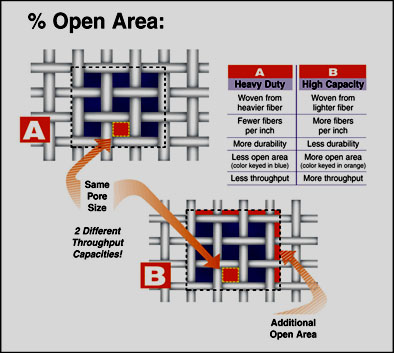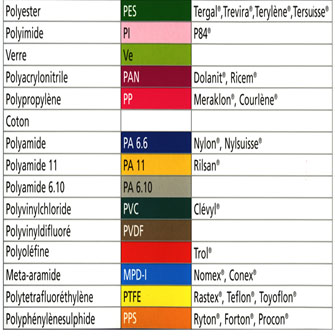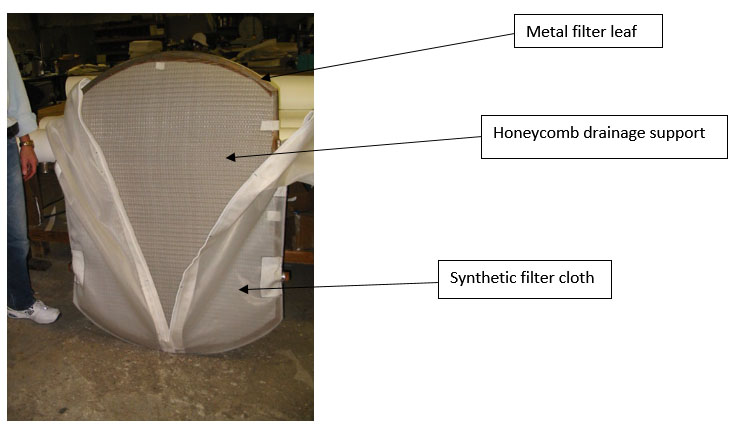TEXTILE FILTER MEDIAS
By: Jose M. Sentmanat, Consultant
Under the broad term of “FILTER MEDIAS” we find “Synthetic Filter Medias” such as: woven filter cloths, woven and non-woven filter media and filter felts. The term “Synthetic” encompasses cloths made of polyethylene, polypropylene, polyester, nylon as well as other special materials such as saran, polyamide, “Nomex”®, peek, fluoroplastic and other specially made materials for specific applications. Originally the material used for filter media were silk, cotton and wool. Due to the limitations on the usability of those materials synthetic materials have become more used in filtration applications. While cotton and wool are still used as filter media, this article will cover synthetic filter media only.
The following chart is about filter cloth media: Common fiber types:
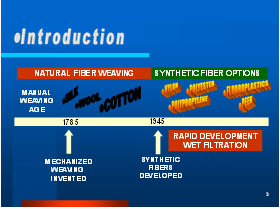
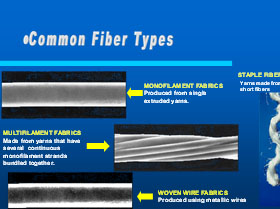
As shown on the above picture, the Common Fiber Types are:
STAPLE FIBER FABRICS: yarns made of many short fibers.
MONOFILAMENT FABRICS: produced from single extruded yarns.
MULTIFILAMENT FABRICS: made from yarns that have several continuous monofilament strands bundled together.
MONO/MULTI FILAMENT, MONO/STAPLE AND MULTI/STAPLE: combinations also available.
FEATURES OF MONOFILAMENT FIBERS: Single solid fiber,
- Excellent diameter control for precise fabric openings
- High flow rates and low pressure drops
- Filtration mechanism is surface particle capture
- Excellent surface particle release, easy to clean
- Relatively high stiffness
- Good tensile strength
- Limited liquid absorption
FEATURES OF MULTIFILAMENT FIBERS: Yarn made from multiple, continuous, small, monofilaments twisted together,
- Twisted yarns often result in uneven yarn diameters
- Pore sizes uneven and difficult to measure
- Filtration mechanisms include particle capture on surface and between twisted strands
- Fair surface particle release, somewhat difficult to clean
- Flexible and pliable with excellent fatigue resistance
- Excellent tensile strength
- Multifilament yarns can absorb liquids
FEATURES OF SPUN FILAMENT FIBERS: Yarn made from multiple, discontinuous small, monofilaments twisted together,
- Somewhat uneven fiber size and density
- Pore sizes uneven and difficult to measure
- Filtration mechanisms include particle capture on surface and within fiber structure
- Poor surface particle release, difficult to clean
- Flexible and pliable
- Spun filament yarns can absorb liquids
COMMON WEAVE STYLES
SQUARE WEAVES, SYNTHETICS

- Most basic open weave
- Simple over and under pattern
- Straight flow path
- Large open area
- High permeability
- Minimal blinding
- Easy cleaning
- High stability
TAFETTA WEAVE, SYNTHETICS:
- Square weave
- Two small diameter threads alternate with larger diameter thread in warp direction
- Rougher surface
- Mimics silk bolting cloth
CLOSED TWILL WEAVE, SYNTHETICS
- 3/1 example
- Warp threads go over 3, then under 1 weft thread
- Very dense patterns
- Excellent strength and durability
- Often calendered to control air permeability
CALENDERING SYNTHETIC
NON-CALENDERED FABRIC
ORDINARY CALENDERING
HIGHEST QUALITY CALENDERING
Calendaring is done by applying pressure and heat at the same time to compress the fibers together, resulting in a thinner and tighter fabric with better filtration quality.
PLAIN REVERSE DUTCH WEAVE: SYNTHETICS
- Higher warp thread count vs. weft
- Warp yarn diameter generally 2/3 weft yarn diameter
- Excellent longitudinal flexibility
- Transversal rigidity
- Tortuous flow
- High flow rates
DOUBLE LAYER WEAVES, SYNTHETICS
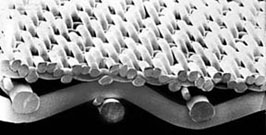
Monofilament Weave Mono-Multi Weave
- Filter and support layers woven together
- Closed twill weave filter layer
- Open square weave support layer
- Fine filtration
- Exceptional strength and durability
- Various constructions available
DOUBLE LAYER WEAVE DETAIL
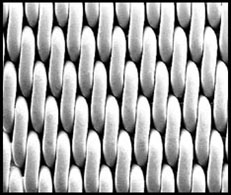
Top view Cross Section View
- Fine fabric is woven onto a strong support layer
- Provides fine filtration and excellent durability
DOUBLE LAYER WEAVE FLOW ADVANTAGE
IMPROVED FLOW AND THROUGHPUT IS THE RESULT
WOVEN FILTER CLOTH PORE SIZE OPTIONS:
SYNTHETICS
- Plain Square Weaves – DOWN TO 5 µm
- Closed Dutch and Twill – DOWN TO 10 µm
PERFORMANCE ISSUES:
When selecting the proper filter media, performance issues taken into consideration are:
1.Particle Capture Efficiency
100% efficiency not often needed (may be too costly)
Fabric pore size doesn’t have to match capture objective (cake
Filtration)
2. Throughput Capacity
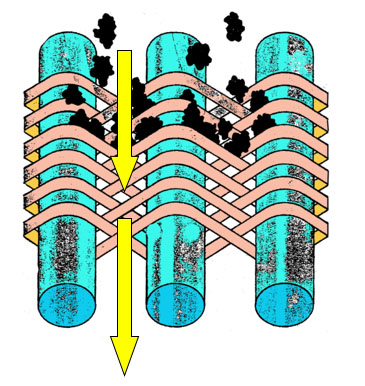
- Washability and Good Cake Release
This is also taken into consideration, how well the cloth can be washed and how well the cake releases when cleaning the filter cloth
- The Fourth and Fifth Requirement is:
Temperature resistance and Chemical Resistance:

Consideration must be given to providing a drainage support between the filter media and the surface under. In the case of a filter cloth media it has been found in some cases that providing a drainage support of a coarse open media may increase flow as much as 20%. The drainage support is either an open square weave made with coarse threads or filaments or what is known as honeycomb. The drainage member separates the cloth from the metal support and thus creating more flow since it allows for a lateral flow under the cloth media. In the case of the woven wire mesh, the drainage member is usually a more open coarse square mesh such as 8×8 mesh. The photo below shows a metal filter leaf with the honeycomb support and the cloth cover open to show the support.
Metal filter leaf with honeycomb drainage support and synthetic cloth cover.
Sometimes, while the filter cloth covers are sewn when installed on the filter leaves, the replacement filter cloth covers may be supplied with either Velcro® closures or zippers to facilitate the field installation and eliminate the need to be sewn that may require sending the filter leaves to a shop for sewing. Care must always be taken to prevent dragging the filter leaves with cloth covers on the floor that will tear or rip the cloth. Also take care not to hit the covered leaves against sharp surfaces that might damage the cloths. The cloths should be inspected periodically for any wear, tears or holes in the cloths that will affect the filter performance. A good preventive measure is to supply the cloth covers with reinforcement patches on either the corners or where the bags may be subject to friction or wear.
Please refer to the following chart as a general chemical resistance chart for various filter cloth materials
ACKNOWLEDGEMENTS:
Writing this article in great part has been due to the valuable contribution of SEFAR AMERICAS INC., BUFFALO, NY and FILTER-ALL, INC./SEWN WELD INDUSTRIES, INC., MAGNOLIA, TX. Also the cooperation and support from GREAT LAKES FILTERS. Also a Technical Bulletin on Filter Cloth by Jose M. Sentmanat, LIQUID FILTRATION SPECIALIST, LLC, CONROE, TX
Written by:
Jose M. Sentmanat, Consultant,
LIQUID FILTRATION SPECIALIST, LLC.
Click Here to Download PDF Version






